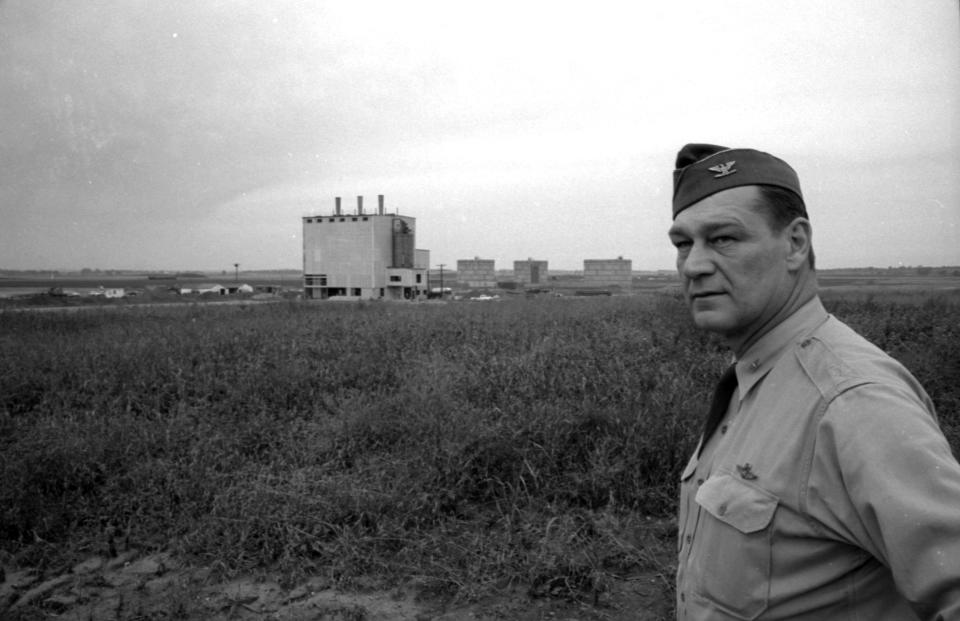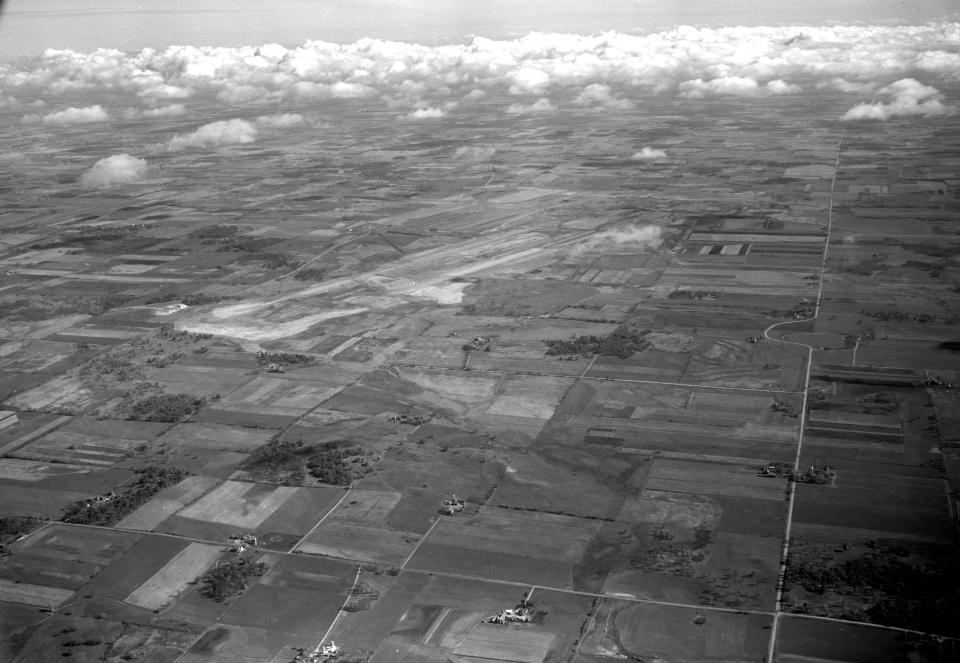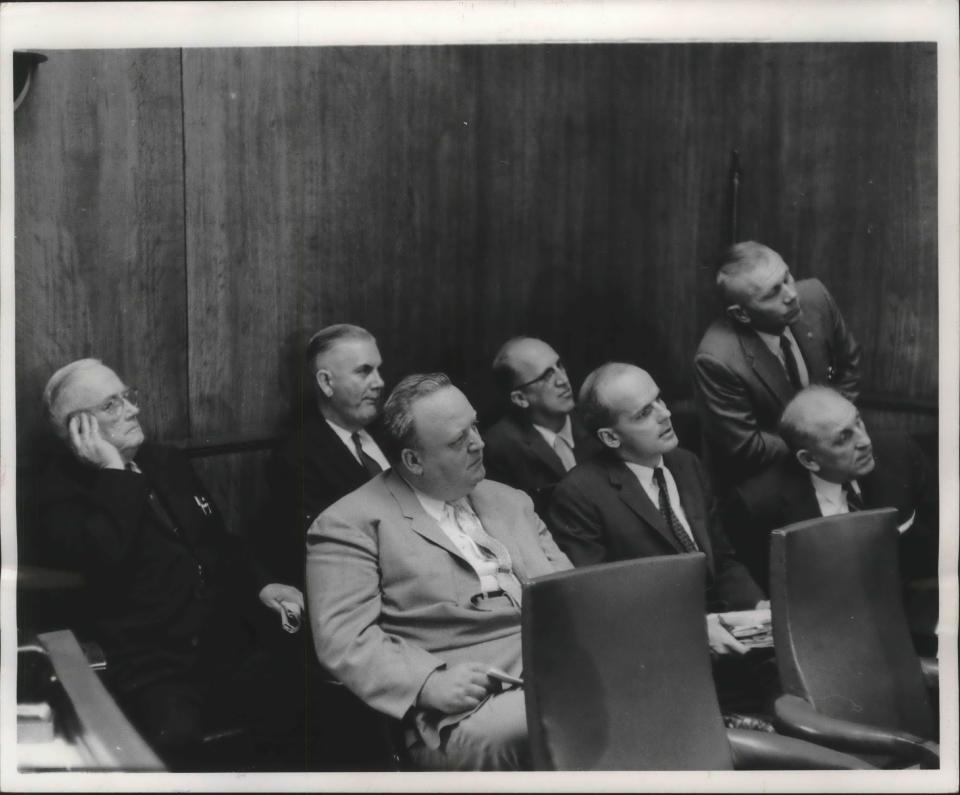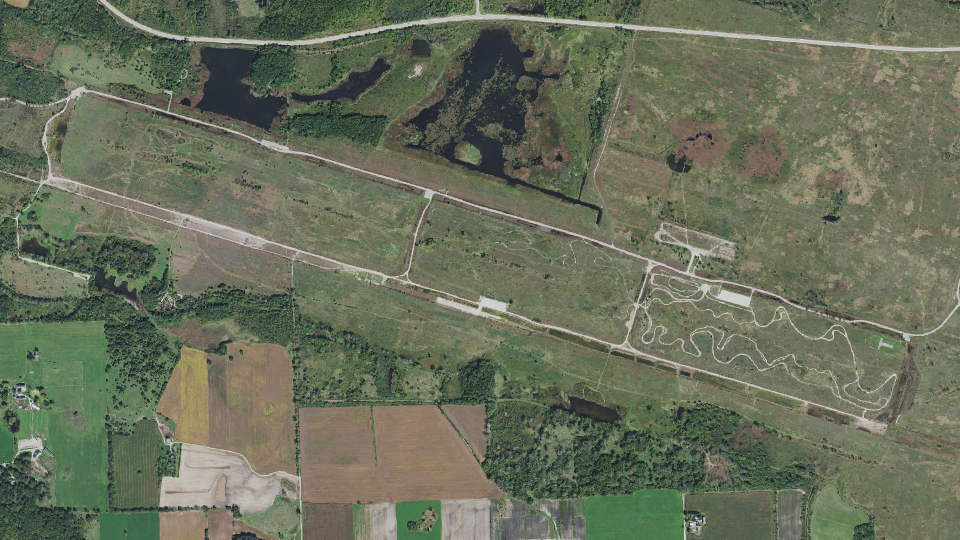The air base that wasn't: How southeast Wisconsin landed, then lost Bong Air Force Base
- Oops!Something went wrong.Please try again later.
In the heart of the Cold War, the U.S. Air Force unveiled plans to build a 5,400-acre, $83 million air base near Kansasville, Wisconsin, in Racine and Kenosha counties.
And then, after four years of work and more than $29 million spent on land, labor, materials and site preparation, the Air Force grounded the project.
How did southeast Wisconsin land — and then lose — a massive military base? That’s what a Journal Sentinel reader asked What the Wisconsin, the place where the Journal Sentinel takes on questions about our state, our communities and the people in them.
The answer involves fear of World War III, swiftly changing military priorities and a lot of money spent on a mostly empty field.

How did Bong Air Force Base get its start?
In the early 1950s, when the United States was ramping up military firepower in the face of a feared war with the Soviet Union, the Air Force began scouting locations for a base for jet fighters to intercept Soviet bombers heading for the industrial centers of Milwaukee and Chicago.
In February 1955, word trickled out that the Air Force had decided to build a massive base near Kansasville in southern Racine County. Two months later, the Defense Department asked Congress to give the authority to spend $16 million on a jet-interceptor base "in the greater Milwaukee area."
When funding for the installation was approved by the House of Representatives on June 27, 1955, the project still didn't have a location but it had a name: the Richard Bong Air Force Base.
Who was Richard Bong?
Born in Superior in 1920, Richard Bong grew up in Poplar, about 20 miles southeast of Superior. Since he was a kid, he had dreamed of becoming a pilot. Bong joined the Army Air Corps in 1940 and was in training when Pearl Harbor was attacked on Dec. 7, 1941.
In the fall of 1942, Bong was attached to the Air Corps in the Pacific. By the time his tour of duty ended in January 1945, Bong had flown 200 combat missions, shot down 40 enemy planes and received the Congressional Medal of Honor.
Bong returned to the States a national hero, doing war bond drives and getting in some flying. He was piloting a P-80 Shooting Star on Aug. 6, 1945, when the plane crashed shortly after takeoff. Bong, 24, still has the most recorded kills of any U.S. military pilot in history.
During the debate in the House over funding for the new air base, Republican U.S. Rep. Lawrence Smith, who represented the area, proposed that it "bear the name of this outstanding Wisconsin hero." It passed unanimously.
Where to put a 5,400-acre Air Force base in southeast Wisconsin?
Meanwhile, people, farms and mink ranchers in the Kansasville area were anxious about when or whether the Air Force was going to take their land.
"We don't like to see our home taken, but if it's needed, they will have to take it … " the wife of one farmer told The Milwaukee Journal in July 1955. "If they would only tell us where we're at … "
Finally, in the fall of 1956, the Air Force decided on a location: about 5,400 acres (35% larger than initially proposed) almost entirely in the town of Brighton in Kenosha County.
Work was expected to start in the spring of 1957, The Journal reported in September 1956. The price tag for the base had grown to $25 million.

Price tag rises to $83 million, and big change causes big delays
Before work began, the Air Force quietly announced a huge change of plans.
In March 1957, Smith, the U.S. Representative whose district included the site, told The Journal that the Bong air base would now be part of the Strategic Air Command system handling long-range bombers, pushing the project's price tag even higher.
Site preparation work on the base finally started in the middle of 1958. Working around the clock, crews cleared trees, demolished buildings and stripped layers of topsoil from acres of farmland.
In a story published in The Journal on Sept. 27, 1959, Air Force Col. Charles E. Lancaster, the base's commander, told Davis that it would be another two years and another $40 million before Bong Air Force Base was fully operational. At that point, a few buildings had been completed and the runways had been laid out but not completed.
Bong Air Force Base cancelled before it was finished
Five days after that story was published, on Oct. 2, 1959, the Air Force announced that it was canceling construction of Bong Air Force Base.
Although the base's price tag had risen to $83 million, only about $29 million of that had been spent.
Turned out the Air Force didn't need it anymore.
Work was to stop immediately — crews had been scheduled to start pouring concrete for the runways in just three days.

Six days after the announcement, Air Force Secretary James H. Douglas came to Racine to tell state and local officials that it was strictly a military decision. He blamed it on shifting budget priorities that included reducing the number of bombing wings operating around the country — sort of the Pentagon's version of "it's not you, it's me."
"I wish the decision had been made sooner," Douglas said in a story in the Oct. 8, 1959, Milwaukee Journal.
What do you do with an unfinished air base?
As soon as the Air Force announced it was halting work on the air base, people jumped in with ideas to replace it.
U.S. Rep. Henry Reuss, a Milwaukee Democrat who had opposed the base, urged turning the site into an international airport. "I'm going to take steps right away to see that everything possible is done to have some use like that for this costly boondoggle," he said.
The Federal Aviation Administration quickly shot down the airport idea. Other trial balloons floated for the site included an industrial park, a state university and a national cemetery.
In the meantime, the federal government sliced off land on the edges of the site for use by nearby municipalities and school districts.
How Richard Bong Recreation Area was born, and what's left of the base
In 1964, the feds sold the two largest parcels of the air base site to the Wisconsin Conservation Commission, one designated for wildlife and conservation use and the other set aside for development.
A year later, the commission scotched the development angle, endorsing a plan to hold the 4,515 acres not already ceded to school districts and other governmental units solely for conservation and recreational use.
Gov. Warren Knowles dedicated the Richard Bong Recreation Area in 1966. Today, Bong has a nature center, picnic areas, camping sites, hunting areas (in season), as well as special areas for riding all-terrain vehicles, horses and off-road motorcycles.
And, in a nod to the site's origins, Bong Recreation Area has an area where visitors can fly rockets, model airplanes and even hot air balloons.
In 2022, 294,550 people used the recreation area, on track with the average usage before the COVID-19 pandemic, said Elias Wilson, former superintendent of Richard Bong Recreation Area, currently superintendent of Kettle Moraine State Park — Pike Lake Unit.
Not much is left of the air base — except for the runway.

Though it was never paved, the 2-mile runway is still visible from above. Today, it's used like a service road for dog trainers and rocketry event attendees to get to more remote places in the park, Wilson said. That traffic has stopped the gravel from being overgrown with grass.
It wouldn't be safe for landing due to the soft gravel and the trees that have grown up around it. To prevent planes from landing on the runway, the park put a pair of large X’s made from cinderblocks on each end to close it off.
Sources: Journal Sentinel archives; "The Base That Never Was" by Robert W. Wells, Saturday Evening Post, Aug. 19, 1961; Bong Recreation Area Master Plan
What's What the Wisconsin?
Is there something about Milwaukee or Wisconsin that's been puzzling you? We've got experts who know how to find answers to even the smallest (and sometimes the most interesting) questions. When we can, we'll answer with stories. Submit your question at bit.ly/whatthewisconsin.
This article originally appeared on Milwaukee Journal Sentinel: What happened to Bong Air Force Base in Wisconsin?

